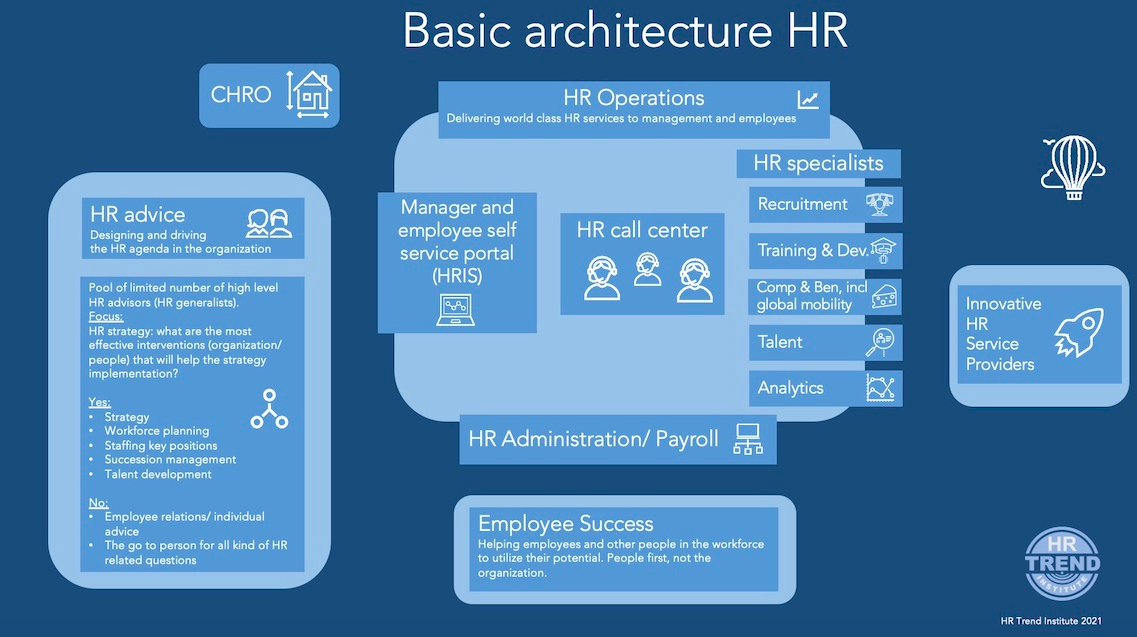10 Trends in HR Organizations

By Tom Haak, Founder of The HR Trend Institute
HR organizations are changing. What are some of the trends we are sensing?
1. HR IS SPLIT UP IN THREE PARTS
- HR OPERATIONS
Most of what HR does, can be captured under the label HR operations. World class HR operations are key, and many organizations are carving out and centralizing HR operations. Outsourcing or partially outsourcing is certainly an option. Centers in Poland, the Philippines and India are delivering high level services at low costs.
- HR STRATEGY/ HR ADVICE/ HR ARCHITECTS
A small group of high-level top HR generalists, working on HR strategy and the HR interventions that drive organizational transformation.
- EMPLOYEE (OR PEOPLE) SUCCESS
Helping employees and other people in the workforce to utilize their potential. People first, not the organization.

2. FOCUS ON SERVICE AND HOSPITALITY
The requirements for the people in HR operations are different, and probably we need a new breed of HR professionals who can run HR as a service organization. In HR services both IT and hospitality are important. Organizations that measure how employees experience their journey, often find that employees are not very happy with how they can find relevant HR information (often on the intranet).
A top-notch HR service centre is very important for a positive candidate and employee experience. 24/7. Friendly chatbots that help employees and managers. High level professionals that can help when the programmed processes do not offer a solution and when the issue is too difficult for the chatbot.
Read their posts: “HR Operations in the lift” and “HR, please give me a menu”.
3. HR BUSINESS PARTNERS IN DECLINE
Twenty years ago, Ulrich and Brockbank published their famous HR business partner model, in their book Human Resources Champions. Although not the intention of the authors, there were clearly perceived differences in status between the different roles. Especially on the dimension Strategic vs Operational, most HR professionals favored strategic above operational.
For years, the ambition of most HR professionals was to become a real strategic business partner. Unfortunately, many HR professionals did not have the skills and experience to realize their ambition.
Today we see the first signs of the decline of the HR Business Partner. The work of most HR Business Partners is not strategic, but operational. Most of their work can be split in three areas:
- Work that should not be done by HR, but by the line managers/ employees (like talking to employees with performance issues).
- Work that can be managed by a HR system (like managing the performance reviews).
- Work that belongs in the HR service centre (like answering all kind of questions from managers and employees).
Big organizations that are transforming their HR, move most of the HR Business Partners and their work to the HR Service Center (where you need less of these kind of professionals).
4. FROM HR TO PEOPLE TO WORKFORCE
HR as a term seems to last long. In the last years, you see ‘HR’ replaced by ‘People’ more and more. Chief People Officers and VP’s of People Operations are popping up everywhere. The next move is probably to ‘Workforce’. The workforce consists of people and robots/ bots of all kinds. The scope becomes bigger than just humans.
5. SPECIALISTS ABOVE GENERALISTS
Most of the people that are needed in HR related professions, will be specialists. Specialists are needed in all kind of old and new areas. Old: recruitment, selection, comp & ben, training and coaching. New: people analytics, agile coaches and performance consultants.
6. EX = CX = MARKETING
HR is currently embracing the employee experience (EX). Here HR can learn a lot from Marketing, who have for a long time been working on designing and enhancing the customer experience (CX). If Marketing is so good at this, why not assign the EX also to Marketing? Most HR efforts today are focused on employer branding and recruitment. Maybe this is better off in the hands of specialists.
7. SHARED RESOURCES FOR ANALYTICS
Data analysts are in high demand. Organizations are gearing up their analytics capabilities in different domains. HR has been lagging, and is now trying to catch up. It makes sense to share the scarce data analytics resources. Create a central team, that can be used by different groups. HR knowledge and experience can easily be added.
8. SYSTEMS TAKE OVER MUCH OF THE TRADITIONAL HR WORK
Although the promises of the big HR systems have been big, many of them have not lived up to the expectations. Early adaptors have spent a lot of money to tailor the systems to their needs, and often the implementation of the HRIS created a lot of work for HR and implementation partners.
Persistence seems to pay off now. The HR systems have become a lot better, and organizations realize that if they want to reap the benefits, they better not tailor too much and they better spend the money upfront, instead of half-heartedly, resulting in slow implementations. Connecting innovative specialized hr tech solutions to the bigger systems is also becoming easier.
9. THE CEO IS ALSO THE CHRO
Modern CEO’s are also CHRO’s or Chief People Officers. Do these CEO’s need a CHRO/CPO in their top team? In many organizations the CHRO is basically the Head of People Operations, with the final responsibility for People/ HR Operations.
The role of strategic advisor in the people and organization domain, can also be fulfilled by others, like the big strategic consultancies or HR strategic consultants.
10. FROM PTB TO EI
The tide is slowly turning, from PTB (please the boss) to EI (employee intimacy). Really understanding the wishes, needs and capabilities of employees is getting more important, and this employee intimacy is required to design relevant employee journeys. The question is, if HR can play an important role in this shift.
There might be others who are better in designing the employee experience (see 6). The boss does not need pleasers but challengers, and this role might be better in the hands of high level strategic consultants.
Originally published at https://hrtrendinstitute.com/.
About the Author
Tom Haak is the founder and director of The HR Trend Institute. Prior to founding the HR Trend Institute in 2014, Tom held senior HR positions in companies as Arcadis, Aon, KPMG and Philips. The HR Trend Institute detects, follows and encourages smart and creative use of trends in the field of people and organizations, and also in adjacent areas.
Ready to hire the necessary talent to complete your winning team and hire a veteran fractional leader? Search the GigX Network (it’s free!). Find fractional CxOs and directors who want to leverage their professional experiences and skills to help your company get more wins.
Ready to join a business that is in need of your specific skill set and lead a team as a fractional leader? Join GigX and create a Network profile.
Already a GigX member? Thanks for being a part of the solution and engaging in the gig economy. We’d love to hear your story about how you’re redefining success as a fractional executive in these changing times. Please email us your story.







